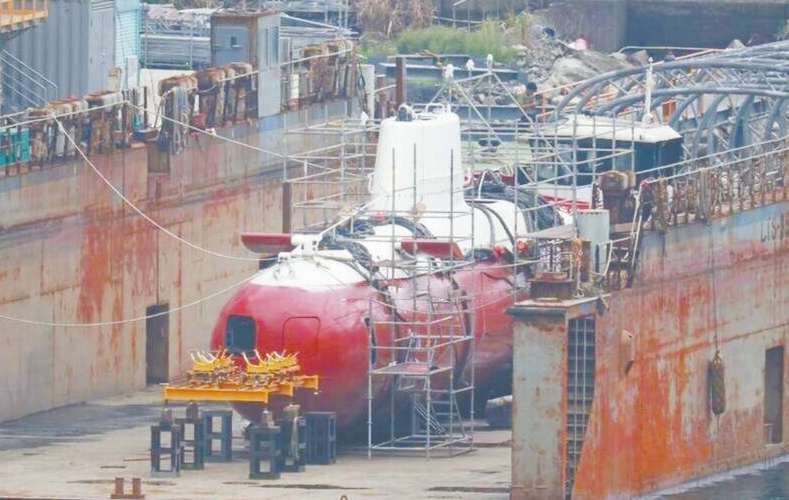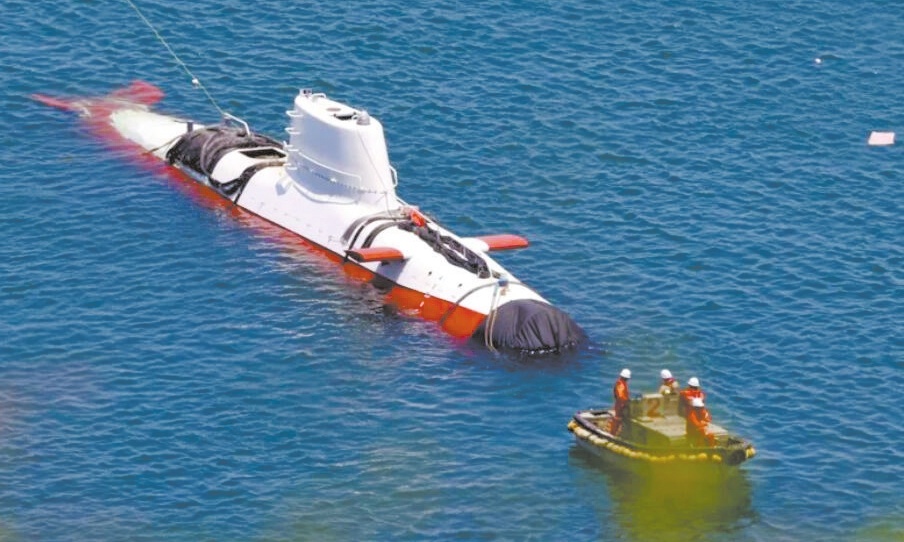While the Taiwanese army is moving ahead with its home-made submarine program, another unmanned submarine, the Huilong, developed by Taiwan’s Chinese Academy of Sciences, has also been in action recently. Taiwanese media said the submarine was a top-secret project that first surfaced in August, but has since made numerous appearances. Taiwan’s“Freedom Times” revealed on the 2nd that it has completed the launch test of a heavy-duty torpedo and the test of a hydrogen fuel cell power system in its recent sea trial, it will lay an important foundation for the future underwater fleet built by the Taiwan Army.
Prepare the unmanned attack submarine
The submarine is an unmanned underwater vehicle developed by Taiwan’s Chinese Academy of Sciences under the codename“Hui Long Project,” and has a displacement of more than 200 tons, rather than the 100 tons rumored by outsiders, according to Taiwan’s Zhongshi news website. The unmanned submarine, which has been under test since December and is expected to take a year to test, was first revealed in August when it was photographed during a test in the port of Su’ao. It is understood that the advantages of this unmanned submarine, including the use of electric drive, very quiet, and small size, not easy to be found, unmanned control is the future of underwater weapons development trend.

The torpedo tube of the unmanned submarine, the Huilong, is visible in the dock
The photos published by the island’s media show that the unmanned submarine“Huilong” uses a conspicuous red-and-white coating. It is about 30 meters long and 3.6 meters wide and looks like a mini-submarine. There is a device similar to a submarine’s sail cover above the hull, the forward part of the hull has two torpedo tube, capable of launching 533mm heavy torpedoes, “The submarine is fully functional and in the future it plans to deploy small unmanned aerial vehicles from the torpedo tube to monitor, lock and attack enemy targets.”. In recent years, Taiwan’s army has emphasized“Innovative asymmetric combat thinking and joint combat capability, and will invest in unmanned vehicle scientific and technological research in the air, water and underwater in the future,” according to Taiwan’s liberty times. People familiar with the matter said that although the main task of the“Hui Long” submarine at present is to serve as an underwater test platform for the reconnaissance equipment of Taiwan’s homemade submarine, after the phased research and development is completed, the future will be based on its further development of unmanned attack submarines.
The report also mentioned that the“Hui Long” submarine has carried out a number of sea trials, including launching a german-made heavy-duty SUT torpedo from the“Hui Long” unmanned submarine, successful verification “Chinese Academy of Sciences” homemade torpedo tube performance has met the standard. At the same time, the Chinese Academy of Sciences presented the research and development results of“Hydrogen fuel cell application” at the recent Taiwan Innovation and Technology Expo, the system has been installed on the“Huilong” unmanned submarine test and“Preliminary verification of its effectiveness.
According to the plan, in addition to the haikun, which is undergoing sea trials, seven more improved models will be built and equipped with a number of taiwan-made weapons systems and equipment. The Freedom Times revealed that although the Huilong will not be Taiwan’s first military unmanned attack submarine, it is the first underwater unmanned submarine with“Combat potential” developed by Taiwan and has valuable experience, it will become an important reference for the island’s new generation of military development, such as“Huilong” unmanned submarine on the test of a number of technologies will be used in Taiwan’s home-made submarines.
“More suitable for fighting in the Taiwan Strait.”
Taiwan’s Shanghai Daily said the Navy had been struggling to develop submarines. Because the average water depth of the Taiwan Strait is only 60 meters, especially the shoals of Taiwan to the southwest of the Penghu Archipelago, which are nearly a quarter of the size of Taiwan’s main island, and the depth of the sea is even shallower, in some areas even less than 10 meters, even large ships can run aground, let alone submarines. Therefore, the Taiwanese army has long believed that submarines can not exert their combat effectiveness in the Taiwan Strait operations. “In addition, it is difficult for Taiwan to directly introduce such strategic weapons as submarines, resulting in a long period of time, Taiwan’s interest in the development of submarines has waned.”.
The report revealed that even after Taiwan made up its mind to push ahead with its homemade submarine program, it still hesitated for a long time to develop medium-sized submarines or small ships. The terrain of the Taiwan Strait is more suitable for small submarines of the 1,000-tonne class or smaller, and the Stegosaurus class of submarines in active service of the Taiwan Navy is too large to be exposed when operating underwater. But according to the plan of the Taiwan Navy, in the future, these submarines will need to stay under the Taiwan Strait for long periods of time to“Prepare to ambush the PLA’s attacking Taiwan Fleet”, while the small submarines can carry only a limited number of torpedoes and supplies, the endurance of submarine navigation is also poor, can not be long-term ambush underwater, the combat radius is more limited.
Therefore, the report said, “Hui Long” the emergence of unmanned submarines for the Taiwan Navy to provide a new choice. The maneuverable unmanned submarine is far easier to hide in the Taiwan Strait than a small conventional submarine, and it is cheaper to build and easier to build in larger numbers, not only spreading the risk of war damage, but also ambushing multiple locations. At the same time this kind of unmanned submarine does not need to float to replenish the air and drink water food and so on, suits the long time underwater standby.
It is worth noting that earlier, the Taiwanese media disclosed that the Taiwanese military’s research and development plan for the underwater unmanned platform will refer to the“Manta Ray” unmanned submarine design developed by the U.S. Defense Advanced Research Projects Agency (DARPA-RRB- , at the same time not limited to their own development, but the use of“Multi-channel access to the required technology.”. Local media said Chen, a DPP “Legislator”, had recently discussed strengthening co-operation on underwater unmanned submarines with his member of the House of Representatives of Japan, Yingjing Suzuki. The government plans to industrialise “Underwater unmanned vehicles” by the end of 2030, the report said, adding that the Ministry of Defense Acquisition, Technology & Logistics Agency also publicly displayed prototype XLUUV vehicles for the first time this year, it is made by Mitsubishi Heavy Industries and is essentially an unmanned submarine. Suzuki, a member of the Diet’s Coalition for the promotion of unmanned aerial vehicles (uavs) , said in a meeting with Chen that he“Looks forward to future cooperation on uavs”.

The unmanned submarine Huilong for sea tests
In addition to the Huilong, the Chinese Academy of Sciences is developing an unmanned attack boat, codenamed Project KUAIQI, which is 2024 to build four prototypes by 2025. The Chinese Academy of Sciences’ previously developed“Project Valor remote-controlled target ship” has the potential to develop into an unmanned suicide attack boat, which could complement the related unmanned underwater vehicle program by adding modules such as radar, weapons, and sonar, to perform near-shore defense, attack, mine hunting, detection of submarine and other tasks. At the same time, the Taiwan Army is also vigorously promoting cooperation with private manufacturers, using these enterprises to develop underwater gliders and unmanned underwater vehicles, semi-submersible suicide attack weapons, “In order to quickly achieve results and accumulate experience.”.
The future of real combat power is not optimistic
U. S. “Power” website also noted Taiwan’s frequent display of“Hui Long” unmanned submarine moves, but the actual effect of the submarine is not optimistic. The report said that the theory of the Taiwan Army’s underwater fleet will be based on advanced conventional submarines for“Asymmetric” operations, the unmanned combat submarine developed from the Hui long may also perform missions such as launching torpedoes or laying mines. “Taiwanese officials have been bold in saying that submarines would be a ‘strategic deterrent’ for the Taiwanese military and could maintain a ‘maritime lifeline’ to the Pacific. But given that the People’s Liberation Army Navy has at least 60 submarines of all types and is rapidly advancing the development and construction of new submarines, the island’s ambitions seem less realistic,” the report said, the People’s Liberation Army Navy are also constantly exploring the battle between unmanned submarines and surface ships, “In a potential conflict, both unmanned and manned submarines will become the main targets of the People’s Liberation Army Navy, and the PLA’s growing anti-submarine warfare capability will prioritise these targets.”
Chinese experts interviewed by the Global Times said that the Taiwan Army, encouraged by the US in recent years, attempts to vigorously develop unmanned submarines, unmanned aerial vehicles and suicide drones and other unmanned equipment as a counter-pla“Asymmetric” combat. However, due to the technical capability of the Taiwan Army, the overall technical level of these devices is rather limited. Experts say the biggest technical difficulty for an unmanned submarine is not the platform itself. It is not difficult to achieve basic underwater navigation or launch torpedoes. The key is how to achieve unmanned combat. In this regard, the Taiwan Army is still at an early stage. Taiwan’s Chinese Academy of Sciences has faced a series of technical difficulties even with relatively simple suicide drones, local media have revealed. For example, the Chinese Academy of Sciences has developed an unmanned attack boat with a hull price of more than NT $250m, eight times that of similar equipment in Ukraine. More importantly, “Apart from having a frequency-hopping anti-jamming system and a satellite navigation system, the remotely piloted UAV itself needs to be equipped with a navigation system that can avoid obstacles autonomously through sensors. It also needs to have the ability to lock onto a target and have a terminal guide to automatically carry out precise attacks on the target, which is quite complicated. The Taiwan Army also envisages controlling 200 uavs to attack at the same time. It can’t be controlled one-on-one, but it can launch a large-scale coordinated attack with the help of an AI management system. These are not its strengths.”
Experts say that because radio waves decay rapidly when they travel in the sea, and because the size of an unmanned submarine is limited, the receiving equipment and sensors it can carry are relatively rudimentary, therefore, the problem of underwater communication and remote control command is more prominent, which requires it to have a higher intelligent ability. This is the problem that the U. S. Navy has been developing in the field of unmanned vessels for many years but has not been able to put into actual combat. Because the Taiwan Army’s technology accumulation in relevant fields is obviously weak, therefore, the“Hui Long” unmanned submarine also lacks the most core intelligent combat capability.